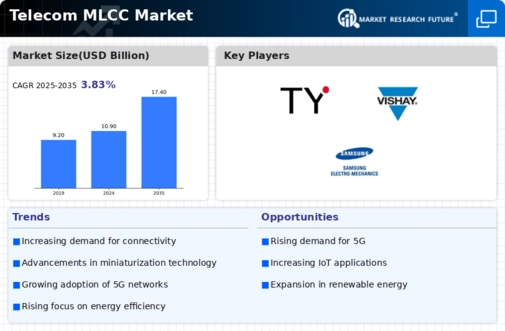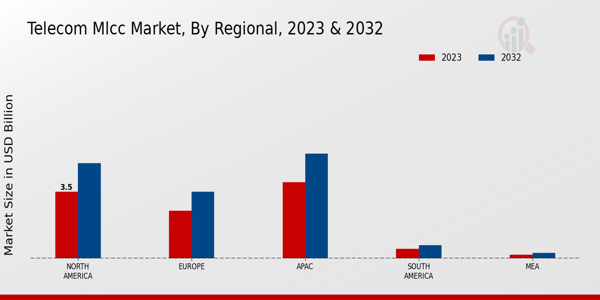Market Growth Projections
The Global Telecom MLCC Market Industry is projected to experience substantial growth in the coming years. With a market value of 10.9 USD Billion in 2024, it is expected to reach 17.4 USD Billion by 2035. This growth trajectory suggests a compound annual growth rate (CAGR) of 4.36% from 2025 to 2035, indicating a robust demand for MLCCs driven by technological advancements and increasing connectivity needs. The market dynamics reflect a strong potential for innovation and expansion, as manufacturers adapt to the evolving requirements of the telecom sector.
Expansion of 5G Infrastructure
The ongoing expansion of 5G infrastructure significantly influences the Global Telecom MLCC Market Industry. As countries invest heavily in 5G technology, the demand for high-performance components, including MLCCs, is expected to rise. This investment is anticipated to contribute to the market's growth, with projections suggesting a market value of 17.4 USD Billion by 2035. The need for enhanced connectivity and faster data transmission necessitates the integration of advanced MLCCs in telecom equipment, thereby fostering innovation and competition among manufacturers in the industry.
Rising Demand for Mobile Devices
The Global Telecom MLCC Market Industry experiences a surge in demand for mobile devices, driven by the increasing adoption of smartphones and tablets. As of 2024, the market is projected to reach 10.9 USD Billion, reflecting the growing consumer preference for advanced mobile technology. The proliferation of 5G networks further amplifies this demand, as mobile devices require more efficient and compact components. This trend indicates that manufacturers must innovate to meet the needs of a tech-savvy population, thereby propelling the growth of the MLCC market within the telecom sector.
Growing Focus on Renewable Energy Solutions
The growing focus on renewable energy solutions is emerging as a significant driver for the Global Telecom MLCC Market Industry. As telecom companies increasingly adopt sustainable practices, the demand for energy-efficient components, including MLCCs, is likely to rise. This trend aligns with global efforts to reduce carbon footprints and enhance energy efficiency in telecommunications. The integration of MLCCs in renewable energy systems, such as solar inverters and energy storage solutions, underscores their versatility and importance in the evolving telecom landscape. This shift towards sustainability may further stimulate market growth.
Technological Advancements in Component Design
Technological advancements in component design play a pivotal role in shaping the Global Telecom MLCC Market Industry. Innovations in manufacturing processes and materials have led to the development of smaller, more efficient MLCCs that cater to the demands of modern telecom applications. These advancements not only improve performance but also reduce costs, making MLCCs more accessible to a broader range of manufacturers. As the industry continues to evolve, the emphasis on miniaturization and efficiency is likely to drive further growth, ensuring that MLCCs remain integral to the telecom landscape.
Increased Internet of Things (IoT) Applications
The proliferation of Internet of Things (IoT) applications is a key driver for the Global Telecom MLCC Market Industry. As more devices become interconnected, the demand for reliable and efficient components like MLCCs escalates. This trend is particularly evident in smart home devices, wearables, and industrial automation systems. The growth of IoT is expected to sustain a compound annual growth rate (CAGR) of 4.36% from 2025 to 2035, indicating a robust market environment for MLCC manufacturers. The integration of MLCCs in IoT devices enhances performance and reliability, further solidifying their importance in the telecom sector.





